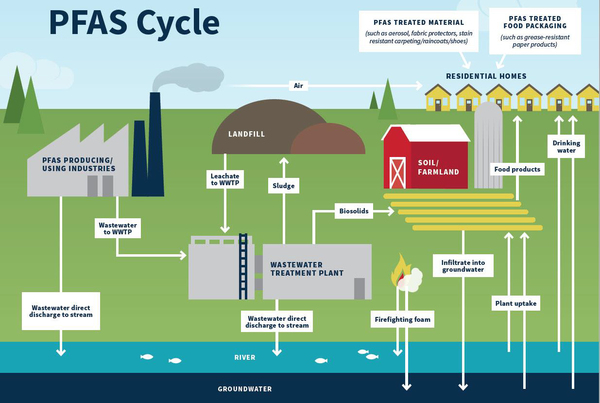Understanding the Evolving Regulation of PFAS Sites and Sources
Author: Courtney Savoie, RG, LHG, PG Published: January 10, 2020If you haven’t heard the buzz and you’re thinking to yourself, “Wait, what’s PFAS?” here’s a recent MFA blog that will introduce you to the topic and get you up to speed.
Now that you’ve read the basics, we’re jumping into a discussion of the evolving PFAS landscape in the United States. As PFAS regulations become more robust, our environmental team is staying on top of updates and their implications so that we can best serve clients who may deal with PFAS in their daily operations or who may be affected by PFAS at neighboring sites.
Common Sites and Sources of PFAS
First, it’s important to understand the types of sites and sources primarily responsible for PFAS entering soil, sediment, groundwater, and drinking water. This map provides a snapshot of where PFAS has been detected in the U.S. The distribution is widespread and is likely to become better known as state regulatory agencies and the USEPA set and enforce PFAS limits, requiring more data collection.
As the map shows, sites with PFAS detections include:
- Sites where aqueous-film-forming foams may have been used for firefighting, such as air force bases, airports, firefighting training grounds, bulk fuel facilities and refineries, railyards, and crash sites
- Industrial manufacturing facilities and sites that may have used PFAS chemicals, including petrochemical and chemical plants; textile and carpet manufacturers; leather-, clothing-, and fabric-treating facilities; and metal-coating and -plating facilities
- Landfills, wastewater treatment plants, and biosolids land applications
The Evolving PFAS Landscape
Most of us are familiar with the conversation around potential chemicals in household items—nonstick cookware, stain-resistant coatings on textiles, and food packaging are just a few examples. But research on the topic of PFAS continues to evolve and has helped us establish guidelines on what is and isn’t worth worrying about in our day-to-day lives.
The ITRC Section 4 tables provide a summary of regulations in the U.S. The USEPA continues to rely on its health advisory limit of 70 parts per trillion (ppt) in drinking water. As of September 2019, 21 states had issued a surface water, groundwater, or drinking water limit for at least one PFAS compound. Fourteen of those states have signed their limits into law. The remaining seven states’ regulatory agencies are relying on their own limits to make decisions. Some states have adopted the USEPA health advisory limit of 70 ppt, while others have issued much lower limits.
States including New York, New Jersey, North Carolina, New Hampshire, and Michigan are suing PFAS manufacturers to create drinking water treatment funds to address future PFAS-caused damages to environmental resources.
As of December 2019, the federal government had taken three important PFAS-related actions:
- The USEPA issued Interim recommendations to address groundwater contaminated with PFOA and PFOS.
- The National Defense Authorization Act for Fiscal Year 2020 was signed into law, adding certain PFAS compounds to the list of chemicals subject to Toxic Release Inventory (TRI) reporting. The update also establishes a framework for including additional PFAS on the TRI list over time.
The addition of these PFAS compounds to the list is immediate, and facilities in TRI-covered industry sectors should begin tracking and collecting data on these chemicals in 2020. Reporting on these chemicals will be due by July 1, 2021, for 2020 data. The USEPA will soon post a list of the PFAS added to the TRI, and information about the TRI reporting requirements is available online.
- The USEPA published an Advance Notice of Proposed Rulemaking (ANPRM) on December 4, 2019, to gather information for use in a potential rulemaking that would add certain PFAS chemicals to the TRI chemical list; however, some known PFAS chemicals have been omitted from the current list.Through the ANPRM, the USEPA continues to solicit comments on PFAS generally as they relate to TRI reporting, including comments on appropriate reporting thresholds, categorization of PFAS, availability of information on human health and environmental toxicity, persistence, and bioaccumulation of these additional PFAS chemicals. Such comments may help determine if the PFAS chemicals meet TRI listing criteria.
Visit the following page for more information on this ANPRM: www.epa.gov/toxics-release-inventory-tri-program/advance-notice-proposed-rulemaking-adding-certain-pfas-tri.
PFAS in Pacific Northwest Drinking Water
Numerous communities in the Pacific Northwest have seen their drinking water affected by PFAS in groundwater from source sites such as those mentioned above. In Washington, the affected communities include the City of Issaquah, Whidbey Island (near a naval station), and the Airway Heights neighborhood of Spokane (near Fairchild Airforce Base). Each of these communities has been dealing with PFAS contamination by using bottled drinking water until treatment systems can be put in place.
In Oregon, PFAS compounds have been detected in groundwater at the Portland Airport, but drinking water in the city is being monitored by the Portland Water Bureau and has remained unimpacted thus far.
The Regional and Federal Implications of PFAS Regulation
The USEPA, the Oregon DEQ, and the Washington State Department of Ecology have pages on their websites dedicated to initiatives addressing PFAS. It is likely that Washington and Oregon will establish regulatory limits for PFAS, and when they do, sampling and analysis at potential sources sites will become more common. MFA’s environmental scientists have experience sampling for PFAS contamination and are diligent in advancing their education and training in this area in order to effectively serve clients who might be impacted by PFAS in their daily operations.
Sampling Considerations for Environmental Scientists
PFAS sampling requires special considerations because of the very low limits (ppt) that many of the regulatory criteria are targeting and the abundance of PFAS used in common sampling equipment (Teflon®-lined jar lids, Teflon-lined tubing), clothing (Gore-Tex®), and consumer products that may find their way onto a site (sunscreen, fast-food wrappers, etc.). There are also special requirements regarding preservation of PFAS samples.
It’s important to consider these factors when designing a sampling and analysis approach for PFAS. Our environmental team at MFA has been diligent in developing PFAS sampling capabilities and establishing best practices, and we are prepared to assist at sites and facilities that may be required to sample for PFAS contamination. Our team is also staying informed about available remedial and treatment technologies that can be used to address PFAS contamination in drinking water and the wider the environment.
Identifying and Analyzing PFAS
Reporting limit needs should be carefully considered when choosing analytical methods. Currently, most laboratories use a modified version of USEPA drinking water Method 537 to identify PFAS in groundwater, surface water, and solids. Method 537 and its modification look for 14 to 24 (modified) PFAS compounds. On December 18, 2019, the USEPA released Method 533, a drinking water method meant to be used in conjunction with Method 537. When combined, these methods can detect up to 29 PFAS chemicals.
As part of SW-846 update VII (the USEPA’s hazardous waste test methods), the USEPA is developing Methods 8327 and 8238 for the analysis of 24 PFAS compounds in groundwater, surface water, sludge, and solid matrices. These methods were issued in August 2019 as drafts for public comment and review. Many laboratories are just beginning to implement these methods.
A few other analytical options are out there, including the TOP assay (which converts PFAS precursors into detectable PFAS) and total fluorine analysis. These are potentially useful as screening methods, but many laboratories do not offer them. Analytical methods will continue to evolve, and close coordination with laboratories is needed to ensure that the appropriate PFAS analyses are conducted.
PFAS and Your Business
As PFAS regulations evolve, MFA remains diligent in preventing and addressing the impacts of PFAS on our environment. If sampling for PFAS becomes necessary at your site in 2020, you can trust that the team at MFA is only a phone call away and can help navigate the complexities of a developing regulatory landscape while assisting your facility in maintaining compliance.
This blog was originally written by former MFA Senior Chemist/Environmental Scientist Erik Naylor.

